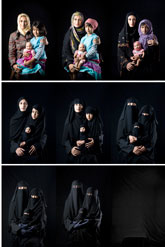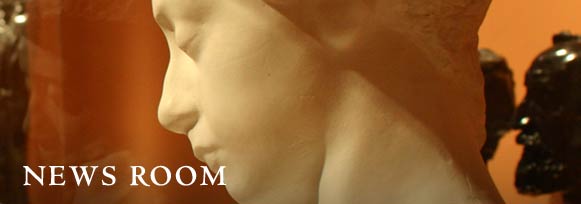Twelve Contemporary Artists
Dynamically Explore Identity, Narrative, and War in Daily Life
She Who Tells a Story: Women Photographers from Iran and the Arab World
January 28–May 4, 2015
Stanford, Calif. —A major new exhibition at the Cantor Arts Center, She Who Tells a Story, presents the pioneering work of 12 leading women photographers from Iran and the Arab world. The artists explore identity, narrative, representation, and war in daily life, inviting a broader understanding of the Middle East than what Westerners glean through media reports. The 79 photographs and two videos—a collection of stories about contemporary life—especially refute the belief that women from this region are oppressed and powerless. The exhibition was organized by the Museum of Fine Arts, Boston (MFA) and runs at the Cantor, its only West-Coast venue, January 28 through May 4.
The 81 works, created almost entirely within the last decade, range in style from fine art to photojournalism and represent the women’s diverse perspectives. The photographers are: Jananne Al-Ani, Boushra Almutawakel, Gohar Dashti, Rana El Nemr, Lalla Essaydi, Shadi Ghadirian, Tanya Habjouqa, Rula Halawani, Nermine Hammam, Rania Matar, Shirin Neshat, and Newsha Tavakolian. In Arabic, the word rawiya means "she who tells a story," and through their work, these 12 pioneering artists collectively portray a region that has undergone unparalleled change and endured continuing conflict.
Exhibition Overview
Amidst the myriad approaches to photography and varied experiences of the artists, the exhibition highlights three themes: Deconstructing Orientalism, Constructing Identities, and New Documentary. While most of the work was made between 2008 and 2012, the exhibition includes two important series from the 1990s that marked a turning point in the recent history of representation and inspired exploration by other photographers. Shirin Neshat’s portrait Untitled (1996), overlaid with Persian script from a contemporary Iranian woman writer, evokes the role that women played in the Iranian Revolution. Iranian artist Shadi Ghadirian took pictures that illustrated issues of identity and being female in Iran. Ghadirian’s eight prints from her iconic series Qajar (1998) juxtapose young women in traditional dress with then-forbidden objects—boom boxes, musical instruments and makeup—suggesting tension between tradition and modernity, restriction and freedom, public and private. Ghadirian’s later series Nil, Nil (2008), meanwhile, visually investigates the home during war through subtle intrusions. The series includes images of bullets protruding from a handbag, a grenade in a bowl of fruit, and a military helmet hanging on the wall next to a headscarf.
Ghadirian’s early staged portraits laid the foundation for later photographers to address the subject of identity. Yemeni artist Boushra Almutawakel’s series Mother, Daughter, Doll (2010), explores the veil in relation to visibility, selfhood, and gender. Lebanese-born Rania Matar’s seriesI (2009, 2010), presents six portraits of young women in their bedrooms surrounded by their belongings.
Moroccan-born Lalla Essaydi, a former painter, uses iconography from 19th-century Orientalist paintings as inspiration to explore her own cultural identity. In the triptych Bullets Revisited #3 (2012), the most expansive work in the exhibition at 5 1/2 x 12 1/2 feet, Essaydi uses calligraphy (a typically male art form) to suggest the complexity of gender roles within Islamic culture. In the triptych, silver and gold bullet casings evoke symbolic violence, referencing her fear about the growing restrictions on women in a new post-revolutionary era that followed demonstrations and protests in the Arab world that began in 2010.
Photojournalist Newsha Tavakolian turned to fine art photography after experiencing difficulty photographing in public in 2009. Tavakolian’s six portraits, six imaginary CD covers and a silent six-screen video from her series Listen (2010) portray professional singers who, as women, are forbidden by Islamic tenets to perform in public or to record CDs.
Each artist approaches the medium of photography differently, resulting in a range of image scale, style, and subject. Artists like Tavajolian are fluent in journalistic as well as fine art techniques, and their work—like that of Gohar Dashti— represents an intersection of documentation, narrative and expression. In this new documentary approach addressing social and political issues, artistic imagination imbues real-life situations and experiences. In Dashti’s Today’s Life and War (2008), a series of narrative, staged photographs, a man and woman pursue domestic activities—laundry, watching TV—in a fictionalized battlefield. In Untitled #5, they sit as newlyweds in the shell of an abandoned car; in Untitled #7, they eat on the ground at a makeshift traditional table celebrating the Persian New Year, Nowruz. The remaining five prints show the couple performing daily routines but interrupted by symbols of war—a tank, missile head and a wall of sandbags.
Contrasting Dashti’s staged documentaries are works by Egyptian Rana El Nemr and Jordanian Tanya Habjouqa that directly capture people in urban settings. In her series Metro (2003), El Nemr has inconspicuously photographed passengers in the transit car designated for women. In Women of Gaza (2009), Habjouqa recorded the experience of women in Gaza, who, like all residents of the occupied territory, live with limited freedom. Taken over a span of two months, the images celebrate modest pleasures, including a picnic on the beach, a rest on a bench between college classes and an aerobics class.
Rula Halawani, born in East Jerusalem, photographed scenes of war—tanks in action, grieving mothers and families in the rubble of the aftermath—and then used a technique that obscures the specifics of time and place, thereby increasing the dramatic intensity. Nermine Hammam’s series Cairo Year One (2011–12) depicts the January 2011 uprising in Egypt and its aftermath. Hammam imbedded photographs of soldiers in Tahrir Square within peaceful landscape scenes from her personal postcard collection. She also created two prints after the uprising was over—when it was difficult for her to photograph—by combining reproductions of 17th and 18th Japanese screens with photos of police brutality.
Artists
Jananne Al-Ani
· Born in 1966 in Iraq, resides in London
· One production still, Aerial I (2011), from the video Shadow Sites II (2011)
Boushra Almutawakel
· Born in 1969 in Yemen, resides in Sana’a, Yemen and Paris, France
· Series of nine photographs, Mother, Daughter, Doll (2010)
Gohar Dashti
· Born in 1980 in Iran, where she still resides
· Five photographs from the series Today’s Life and War (2008)
Rana El Nemr
· Born in 1974 (Egyptian; born in Germany), resides in Egypt
· Four photographs from the series The Metro (2003)
Lalla Essaydi
· Born 1956 in Morocco, resides in Morocco and New York
· Photographs Converging Territories #29 (2004) and large-format triptych Bullets Revisited #3 (2012)
Shadi Ghadirian
· Born in 1974 in Iran, where she still resides
· Five photographs from the series Nil, Nil (2008–9)
Tanya Habjouqa
· Born in 1975 in Jordan, resides in East Jerusalem
· Six photographs from the series Women of Gaza (2009)
Rula Halawani
· Born in 1964 in East Jerusalem, where she still resides
· Six photographs in the series Negative Incursions (2002)
Nermine Hammam
· Born in 1967 in Egypt, resides in Egypt and London
· 10 photographs in the series Cairo Year One: Upekkha (2011) and two photographs from the series Cairo Year One: Unfolding (2012)
Rania Matar
· Born in 1964 in Lebanon, resides in Brookline, MA
· Six works from the series, A Girl and Her Room (2009–2012)
Shirin Neshat
· Born in 1957 in Iran, resides in New York
· Four photographs from the series Women of Allah (1993–97), the photograph Mystified (a film still from the 1997 video Turbulent); and eight photographs from the series Book of Kings (2012)
Newsha Tavakolian
· Born in 1981 in Iran, where she still resides
· Twelve photographs and one six-screen film from the series, Listen (2010)
Publication
A catalogue accompanies the exhibition (MFA Publications, September 2013). The 176-page book is authored by exhibition curator Kristen Gresh, the MFA’s Estrellita and Yousuf Karsh Assistant Curator of Photographs, and features essays by independent curator and art critic Michket Krifa. The catalogue is for sale at the Cantor Arts Center and at mfa.org/publications.
Exhibition Tours
Beginning February 5, free, docent-led tours take place on Thursdays at 12:15 pm, Saturdays and Sundays at 2 pm, February 5–May 3. Meet in the main lobby.
Exhibition Organization and Support
She Who Tells a Story: Women Photographers from Iran and the Arab World was organized by the Museum of Fine Arts, Boston. After presentation at the Cantor Arts Center, the exhibition goes to its final venue, the Carnegie Museum of Art, for viewing from May 30 to September 28, 2015.
The exhibition’s presentation at Stanford is made possible by generous support from the Clumeck Fund and the Mark and Betsy Gates Fund for Photography. The Cantor's Stanford community partners include the Abbasi Program in Islamic Studies, the Hamid and Christina Moghadam Program in Iranian Studies, and the Clayman Institute for Gender Research.
Cantor Arts Center
The Cantor Arts Center at Stanford University is a vital and dynamic institution with a venerable history. Founded in 1891 with the university, the historic museum was expanded and renamed in 1999 for lead donors Iris and B. Gerald Cantor. The Cantor’s encyclopedic collection spans 5,000 years, includes more than 40,000 artworks and beckons visitors to travel around the world and through time: from Africa to the Americas to Asia, from classical to contemporary. With 24 galleries presenting selections from the collection and more than 20 special exhibitions each year, the Cantor serves Stanford’s academic community, draws art lovers from the San Francisco Bay Area and beyond and attracts campus visitors from around the world. Free admission, free tours, lectures, family activities plus changing exhibitions make the Cantor one of the most well-attended university art museums in the country and a great resource for teaching and research on campus.
Visitor information
The Cantor Arts Center is open Wednesday–Monday, 11 a.m.–5 p.m., Thursday until 8 p.m. Admission is free. The Cantor is located on the Stanford campus, off Palm Drive at Museum Way. Parking is free after 4 p.m. weekdays and all day on weekends and major holidays. Information: 650-723-4177, museum.stanford.edu.
# # #
Notes to Editors
• To arrange an interview, obtain an exhibition checklist or request an exhibition catalogue, contact Anna Koster, Head of Communications, Cantor Arts Center, 650-725-4657, akoster@stanford.edu
• For high-resolution publicity images, contact PR Assistant Manager Margaret Whitehorn, Cantor Arts Center, 650-724-3600, mmwhite@stanford.edu
![]()
This exhibition was organized by the Museum of Fine Arts, Boston

Gohar Dashti (Iran, b. 1980), Untitled #5 from the series Today’s Life and War (detail), 2008. Pigment print. Courtesy of the artist, Azita Bina, and Robert Klein Gallery, Boston. © Gohar Dashti

Boushra Almutawakel (Yemen, b. 1969), Mother, Daughter, Doll from The Hijab Series, 2010. Series of nine pigment prints. Museum of Fine Arts, Boston, Museum purchase with funds donated by Richard and Lucille Spagnuolo Photography © 2014 MFA, Boston

Rana El Nemr (Active in Egypt, b. Germany 1974), Metro #7, 2003. Pigment print. Museum of Fine Arts, Boston. Museum purchase with general funds and the Abbott Lawrence Fund. Photography © 2014 MFA, Boston

Shirin Neshat (Iran, b. 1957), Roja, 2012. Gelatin silver print with India ink. Museum of Fine Arts, Boston, Charles Bain Hoyt Fund and Francis Welch Fund. Photography © 2014 MFA, Boston



